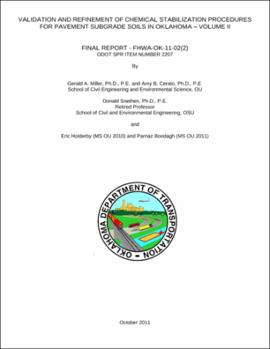| dc.description.abstract | For projects involving a chemically stabilized layer as a part of the structural design of the pavement, it is typical to conduct a mix design to assess the additive content needed to achieve a certain unconfined compressive strength (UCS) and to determine the resilient modulus (MR) of the stabilized soil. However, there is considerable uncertainty regarding whether the strength and resilient modulus of the field stabilized soil are consistent with design values determined in the laboratory. A purpose of this study was to compare results of field tests and laboratory tests on chemically stabilized soil at different curing times to assess whether a relationship exists between field and laboratory measurements. The goal was to determine if a field testing method could be used to assess whether the strength and stiffness in the field are consistent with laboratory measurements used for design. In addition, numerous other physical and chemical tests were conducted on the soils with an aim to enhance interpretation of UCS and MR and comparisons to field tests.
Field testing included three devices that are portable, quick, and easy to use. These devices include: the Dynamic Cone Penetrometer (DCP), the PANDA penetrometer, and the Portable Falling Weight Deflectometer (PFWD). Laboratory testing was conducted to determine the unconfined compressive strength (UCS) and resilient modulus (MR) of laboratory specimens prepared using additive contents that were similar to samples taken from field test locations. To estimate the additive contents in the field samples, a mineralogical test method known as “whole rock analysis” using x-ray fluorescence (XRF) was investigated. Samples mixed in the laboratory were tested to determine the UCS and MR after curing times of 1, 3, 7, 14, & 28 days. Field tests were conducted at each of the five test sites after curing times that fell within the 1 to 28 day time frame; however, because of construction logistics and weather conditions it was not always possible to match the curing times of laboratory tests or conduct field tests over the full 28 days at every site. Nevertheless, sufficient field data was collected to make meaningful comparisons with laboratory test data.
Mineralogical, electrical, chemical, physical and index property testing (Atterberg Limits, linear shrinkage, Total Specific Surface Area (SSA), etc.) was conducted on the natural soils and the stabilized cured samples to observe the relationship of these properties to stabilized soil strength and stiffness. The effect of curing temperature on stabilized strength gain of soils was also examined. The UCS samples were cured at both room temperature (68°F) and at 40°F, which is the minimum ambient temperature specified for chemical stabilization of subgrades.
Correlations were examined and involved basic soil measurements (mineralogical, electrical, chemical and index properties) and mechanical properties (UCS and MR), and field test results (DCP, PANDA, and PFWD). Some of the various correlations developed show promise as methods for predicting UCS and MR based on more simply measured soil properties. Relationships between field and laboratory tests also show promise as a means to evaluate strength and stiffness gains in field stabilized soils. Additionally, lower curing temperatures were observed to have an adverse affect on more reactive clayey soils. | |
